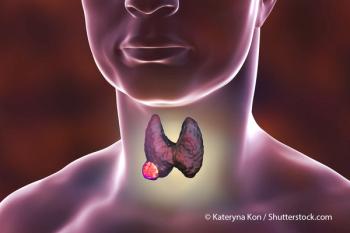
BLU-667 Shows Promise for Thyroid Cancer in Clinical Trials
Findings on the efficacy of the RET inhibitor BLU-667 in RET-altered medullary thyroid cancer and papillary thyroid cancer patients was presented at ASCO 2019.
The highly potent and selective RET inhibitor BLU-667 demonstrated antitumor activity and was well tolerated in RET-altered medullary thyroid cancer and papillary thyroid cancer patients despite resistance to multikinase inhibitors, according to the results of a study presented at the American Society of Clinical Oncology (ASCO) 2019 Annual Meeting (
This study is an update to the ARROW trial, which is a global dose exposure (30–600 mg daily [QD or BID]) and dose expansion (DX; 400 mg QD) study in patients with advanced solid tumors. The primary endpoints were overall response rate (ORR) and safety.
“This is an exciting time in medullary thyroid cancer,”
Busaidy noted that RET inhibitors “appear to be better tolerated than the US Food and Drug Administration (FDA)-approved cabozantonib/vandetenib, but no head-to-head studies have been done.” Both cabozantonib and vandetenib are FDA-approved tyrosine kinase inhibitors that interfere with tumor angiogenesis in thyroid cancer.
According to Busaidy, BLU-667 inhibits the RET gene whether the RET gene is present as part of medullary thyroid cancer or as a RET fusion in papillary thyroid cancer.
Although pleased with the results, Busaidy and her colleagues expected BLU-667 to be more effective. “They had a fairly good response rate of 47%. That’s the good news…47% of the time, we had good shrinkage. Personally, however, a lot of use expected a lot more shrinkage. If RET is the true driver, we would expect this entire tumor to disappear, which means that there are other things that are driving [tumor growth] in addition to RET.”
The study included 60 patients with RET-mutated medullary thyroid cancer and 5 patients with RET-fusion–positive papillary thyroid cancer. In total, 58% received prior multikinase inhibitor therapy. The ORR was 47% (95% CI; 33–62) among 49 response-evaluable medullary thyroid cancers. Furthermore, 96% (22/23) of responding patients continued treatment, with 15 exhibiting a response duration ≥ 6 months.
Two of 4 evaluable papillary thyroid cancer patients experienced a partial response, with all 5 enrolled patients continuing treatment at 8–11 months. Treatment-related toxicity in medullary thyroid and papillary thyroid patients was typically low-grade and reversible and included neutropenia, increased liver enzymes, and hypertension.
RET alterations are found in about 90% of advanced medullary thyroid cancers and 20% of papillary thyroid cancers, yet no selective RET inhibitors are currently approved by the FDA.
Newsletter
Stay up to date on recent advances in the multidisciplinary approach to cancer.





